Unethical Grade Bumping Scams And How to Avoid Them

Can you trust the jeweler when it comes to a diamond purchase?
Ever since the existence of trade, people have set out to earn the highest profit possible when selling their merchandise. This phenomenon propels economies in all types of businesses around the world.
Now, it shouldn’t be a surprise that a profit-orientated mindset is present in the diamond trade too. While this is not a bad thing in itself, the problem is that some people may stop at nothing to achieve that desired profit margin. Especially if that means turning to dubious and unethical methods to do so.
And in the diamond industry, grade bumping is one of these methods employed by unethical jewelers to take advantage of inexperienced buyers. This is why I wanted to dedicate an entire article to help you avoid getting conned and ripped off during a jewelry purchase.
What It Is And How Does Grade Bumping Works?
As the Latin phrase ’Nomen est omen’ goes, grade bumping is the intentional misrepresentation of a diamond’s color or clarity grade by its seller (whether it is uncertified or has a dubious grading report). Believe it or not – while this practice is clearly unethical, it isn’t illegal.
Loopholes in federal regulations make this appalling phenomenon possible and widespread.
In fact, the Federal Trade Commission’s own regulations state that an uncertified diamond could be sold within one color and one clarity grade of what the original stone is. There are 2 issues here that I want to highlight.
The first is, what are the kind of benchmarks used for the grading standards? Are we talking about GIA’s strict level of evaluation or referring to questionable systems from labs like EGL? These are vague rulings that jewelers can easily twist and abuse to their advantage.
The second point is that huge amounts of money are involved even with one or two color/clarity grade differences. Take for example a diamond with VS2 clarity and G color may typically sell for $4000.
However, because of the permissive regulation, an unethical seller can pass this stone up as a VS1 clarity, F color stone, making it seem more valuable on paper than it actually is. This means the unethical jeweler can now sell the stone at $5000 for a higher profit.
Dangers of Buying And Comparing Diamonds in Person
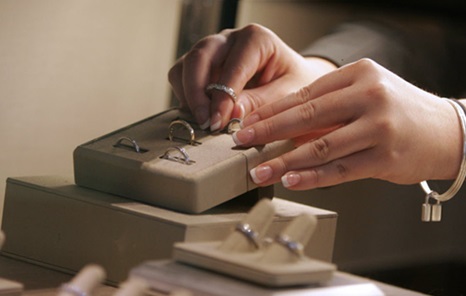
Unfortunately for the buyer, they are usually at a disadvantage when buying diamonds since it is very difficult for the untrained eye to identify a diamond’s actual properties. Besides that, it is also possible for jewelers to manipulate the showroom’s lighting or the comparison stones you are shown in his favor.
Case in point. Even though I am a trained diamond grader, I would not be able to assess a diamond’s qualities accurately without proper tools and lighting conditions.
While it may seem hard to believe that such frauds exist, don’t forget that an unethical jeweler could be thinking along the lines: “If I can do it, why shouldn’t I?” – And once the transaction has been completed, there’s really no way back without any pre-written agreements since he is no longer legally liable for your purchase.
All you can do is tell people to stay away from that place but the damage is already done.
4 Telltale Signs of Misrepresentation & Grade Bumping Fraud
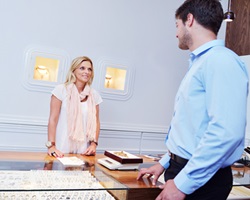
Don’t fall for these marketing tactics that jewelers use to entice unsuspecting shoppers.
#1: Prices that are too good to be true. One of the easiest ways to identify misrepresented diamonds is that their prices are often too good to be true when compared to GIA/AGS diamonds with similar ratings. The fact is, high quality diamonds are never on sale and if you come across “massive sales”, you better be skeptical about what is being sold.
#2: Hard selling and time sensitive discounts. If you’ve been shopping at local jewelry stores, a marketing tactic you will come across is the offer of a “huge discount” to entice you into a deal. Usually, this “great bargain” is valid only for a limited time and only if you commit on the spot. Don’t be fooled. This is just an attempt to prey on consumer greed and push you into making a rash purchase.
#3: Uncertified diamonds and non-GIA/AGS grading reports. If a jeweler is trying to sell you a non-certified diamond or a diamond with a dubious grading document, ask the jeweler why they didn’t choose to have it certified by well-known labs like GIA or AGS.
Unethical jewelers will often tell you to “Buy the diamond, not the paper” or feed you bullshit like “You will enjoy better savings without a certificate!”. You could even test them by asking how much it costs them for proper certification.
The truth is that the cost of getting a diamond “certified” at GIA is only $105 for a 1 carat stone. This cost is relatively small compared to the price tag pegged to the diamond. From experience, I can assure you that 99.99999% of “uncertified” stones have significantly lesser quality than what it is being represented as. You aren’t getting a great deal with such stones; the jeweler is.
#4: Is the jeweler willing to put their claims into writing? If you are buying an uncertified diamond, ask the jeweler whether they will offer any form of guarantees in writing or that the sale is contingent on the results of an independent examination.
Are they willing to bear ALL the costs involved in grading/appraising a diamond if you bring it to GIA for grading and it comes back with an unfavorable result compared to the quality claimed by the jeweler?
Beware of jewelers who are not willing to put facts in writing or attempt to funnel you to an “independent appraiser” of their choice.
What Can You Do to Avoid Becoming a Victim of a Grade Bumping?
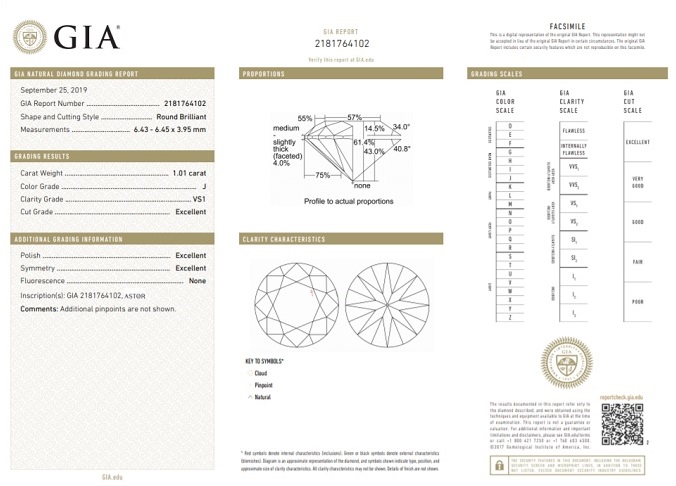
Sample grading report from GIA for a 1ct loose diamond.
As I mentioned in the previous paragraphs, this kind of fraudulent activity is only possible when consumers buy diamonds without certificates from reliable 3rd party labs.
If you want to avoid getting ripped off, you should never buy a diamond without a reliable certification. Even though I am a trained professional in the industry, I only buy diamonds that are graded by AGS and GIA. That should speak volumes.
Why? That’s because I know there are NO deals that end up in the favor of the consumer when buying unreliably certified diamonds.
If you only buy a diamond that is graded by a reliable 3rd party lab like GIA or AGS, you will take the seller’s vested interest and biased opinion out of the equation. This means you can eliminate any doubt about the seller’s trustworthiness and you will be sure the diamond you purchased actually has the qualities you had paid for.
To wrap things up, the grading report is a really important document you need to pay attention to when buying a diamond. You should also make your buying decisions based on tangible information like magnified videos or analytical scope images.
Good luck in your search! If you have any questions, feel free to leave a comment or get in touch directly with me!
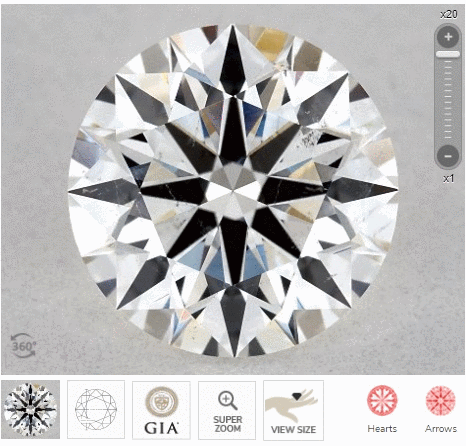
Click here to view the diamond listing with magnified video and tangible cut performance data.
Related Articles
Leave A Comment

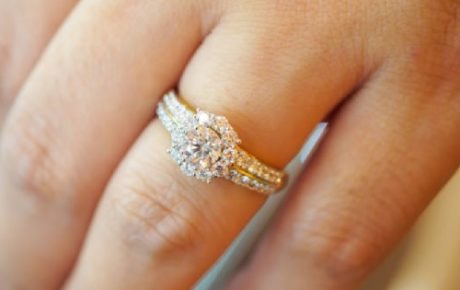
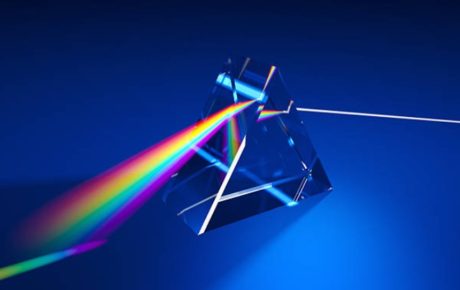
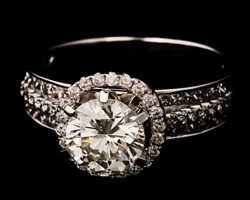










12 Comments
I would have liked some more opinions in there on things like – coloured diamonds – I know the quality of the particular diamonds is key. Yet, info on this seems to be rare – leaving consumers at the mercy of copywriters (like me) and presenters on shopping channels.
Are some colours more valuable than others or is it dependent on fashion, availability on current stones on the market, etc?
One particular point I was researching (and I think is a very overlooked aspect of diamond buying – Google & Bing searches seem to agree) is this –
How do diamonds compare with, say, gold, silver, platinum, etc on a value-weight ratio? How would they compare on a scale?
Why is this relevant?
At the moment, gold and silver are being given the hard sell as stores of wealth by gold sellers and their many affiliates too. People are worried about economic turmoil are acquiring physical gold as a backup asset. They always have, of course, but the trend seems higher than ever.
Diamonds could, arguably, be another diversified asset, very compact and easily transportable, concealable, lightweight and wearable. Also a diamond is clearly a diamond.
Appraisal by a skilled jeweler is easier compared to gold which has multiple sophisticated scams going on right now and multiple testing parameters.
Fake gold bars and coins and jewelry are being produced on an epic scale and testers are having to use x-rays, drilling, ultrasound, etc and many audits have revealed. Fake bars even inside bank vaults!
You can’t melt down a diamond and mix it with non-diamonds or fill it with glass!
I was looking for a scale similar to the attached photo. Given the density of gold, and the gradings and variety of cuts available with diamonds, I am surprised this selling angle is not used more often.
Have you seen it used yet? Or am I just ignorant?
Thanks,
Red diamonds are the most valuable diamonds because of their rarity. The pinks and blues also fetch record prices if they are of a certain size and quality. But in general, diamonds are poor investments. You are almost guaranteed to lose money on purchases unless you are talking about those record breaking diamonds in the multi million figures.
Gold is the best buy if you are looking for storage in value overtime (depends on the market though). If you want to compare relative value to weight, it depends on a lot of factors. Gold is straight forward. 24k means 99.99% purity but when it comes to diamonds, factors like clarity and color play a role in the value of the stone.
Paul
We saw two identical cathedral ring settings with 1 carat diamonds mounted on them in a NYC store. One was a D VS1 while the other is a G VS2. If the diamond has already been mounted, how do we know and prove that the diamond we bought is what was stated on the certificate?
If they came with reliable GIA or AGS reports, match the inscription number on the girdle to the diamond (at the girdle). The next thing to do is to match the inclusions according to what was stated in the clarity plot. If you can do this with a microscope, it confirms the identity of the diamond.
As for cathedral settings, this recent write up might interest you: https://beyond4cs.com/engagement-ring/what-is-a-cathedral-diamond-ring-setting-style/
I was hoping you could provide some guidance about a vintage engagement ring I’m interested in purchasing. The link to item is here: https://www.etsy.com/listing/570885707/hold-circa-1930s-art-deco-platinum-99ct
I live in New York and I was able to see the ring in person. I was quite beautiful and I noticed some light wear to the band, which they were upfront about, but I was concerned about some red flags I noticed on the Etsy profile.
The diamond certificate is from GAI, rather that the better known GIA. I had initially thought that this was a typo, but doing some of my own research it seems like GAI is another third party appraiser though it’s unclear of what quality. I asked the sellers about this and they said that GIA does not grade mounted stones– is this true?
Looking on your website it seems like your expertise is in diamonds, but I was wondering if you had any tips or suggested questions I should ask about the vintage ring. When I wanted some more documentation or information about how the sellers were able to place the ring from the 1930s, they basically said just trust us.
Thank you for all your help!
Sam
The grading report is a giant rip off. It’s misrepresented for quality and that’s how the scummy sellers take advantage of people. I suggest you buy the diamond ring elsewhere from a proper and reliable vendor.
https://beyond4cs.com/engagement-ring/beware-of-cheap-diamond-deals/
Hello Paul,
Hope all is well. I contacted you previously regarding purchasing diamonds. I flew over to the store in another country to check out a diamond I was presented and I liked it for it’s price. It retailed for about $59,000 USD. I’ve attached the details of it again. A friend of mine who is in the jewelry industry and he is a professor said that on paper it looks amazing but the only concern he has is the fluorescence of the diamond. I was a bit confused when I searched up the concerns regarding a diamond’s fluorescence because some websites explained that it doesn’t make much of a difference whereas some say it does.
At the same time, I checked with the store owner and she assured me that their family has been in the jewelry business for 30-40 years and their stores are in some of the best hotels and malls in the city. Moreover, they have a strong clientele base of even royalty from the Middle East and celebrities and that she would never sell me something of bad quality. She also mentioned that anytime I would like a ring upgrade, I could come back in a few years and bump the carat sizes up by a few (once they take 30% of the ring value depreciation into account). So that made it seem pretty legit to me to be honest.
Lastly, a friend of mine who is also in the jewelry business did mention that there have been a lot of scams when it comes to diamonds such as people leaving the inside of a diamond hollow, especially bigger diamonds, and that freaked me out.
So I wanted to know your opinion once again. To be honest, I’m not too picky about the HRD or the GIA certificate but I just needed to know whether I would be making a huge mistake purchasing this. Also, if there’s anyway I can actually get in touch with you for example via whats app or even if we could meet for coffee where we could discuss this further, I would be more than honoured to! Thank you and hope to hear from you soon!
Well, I can tell you your “professor” friend probably knows nothing more about diamonds than you do. It’s a shame that people in the industry are behaving in this manner. On paper, the report says Nothing about the diamond’s appearance.
You should read these articles:
https://beyond4cs.com/buying-diamonds-blind/
https://beyond4cs.com/diamond-certification-mistakes-to-avoid/
As for fluorescence, I’ve stated my opinion on that matter here: https://beyond4cs.com/grading/fluorescence/
And ASSUMING (that’s a big assumption) that the diamond is correctly graded by HRD, the medium strength fluorescence shouldn’t cause any issues. From the video, I don’t see any haziness or impact on it.
And you are running around in circles. Apparently, you don’t trust what these people say and that’s why you are asking me for my opinion. If you don’t trust them, why even bother considering a diamond from them?
And by the way, (once they take 30% of the ring value depreciation into account) is a really lousy sales and upgrade policy. The reliable vendors that actually care about clients do this way better and offer 100% credit if you choose to upgrade. I expect nothing less than a 100% credit towards a new purchase. That’s the bottom line.
I will put things bluntly.
There’s a reason why you should only buy GIA and AGS diamonds and that’s to protect YOUR INTEREST as a consumer. The accuracy of color/clarity is questionable and I don’t put weight on whatever HRD says. They can be right or could be grossly wrong.
https://beyond4cs.com/grading/difference-between-gia-ags-egl-igi/
Now, from the video, I can tell you that this is a decently cut emerald cut diamond. Is it top of the line? Definitely NOT. Is it terrible? It isn’t. Is it a stone I would buy? Definitely not. And those 2 strikes come from who graded the diamond (HRD) and its cut quality.
If I am buying such a large stone, I expect nothing but the best in performance.
I live in the Philippines and not a lot of people buy diamonds here. Because of this, the local jewelry stores only have small sized diamonds and few are GIA certified. I tried buying online at the vendors you recommend and they say they don’t ship to Phillipines because of fraud issues. Is this true?
I happen to be travelling to Hong Kong next month and White Flash told me that they can ship the diamond ring to a holding facility in HK using Fedex. Is this the normal?
This is true. Just like skeptics like you think that online vendors are unreliable, the online diamond businesses are worried about getting scammed just like you do. They learned this the hard way like many of the other vendors I recommend.
Countries like the Philippines have issues with fraud and shipping insurance. As far as I know, most companies would rather not sell to these countries rather than run the risk of fraud and shipping issues.
Here’s what I tell people to do if they want to buy online and they happen to be from countries that are blacklisted. (i.e. Indonesia, Malaysia, Philippines)
Vendors like White Flash ship to Hong Kong (at Fedex pickup point in Central) and you can opt to ship your package there and pick up in person. The advantage of doing this is that Hong Kong has ZERO luxury taxes. I have readers from Singapore who do the same. Even though these vendors ship to Singapore, they would rather fly out to Hong kong to pick up the item and avoid the local taxes.
Since you happen to be heading to Hong Kong, this route makes perfect sense.
Hi Paul. I would rather you did not use my surname incase someone see’s this post before I propose.
Your site and advice is excellent. Whatever I end up choosing I know I will be getting a far better deal than if I had not found your site.
However. Where do I buy my ring and diamond? Every jeweller in Hatton Garden has told me to keep away from buying online and every online company say keep away from buying downtown especially Hatton Garden?
Buying Downtown
Pros:
I get to see the diamond and the ring. Sometimes pictures are not just good enough.
Cons:
I am buying something I know very little about from a company that may have been in business a few days. Your site has improved my knowledge but that does not make me an expert.
Even if a company has been in business for decades that does not make them a reputable company. They may just be good at pulling the wool over peoples eyes.
I am sure it is quite possible that even if i find the right diamond they could be switched during the setting.
They could give me a certificate yes, but how do I know that certificate matches the diamond I chose in the first place? Are they layered for identification?
They have large overheads to keep the shop open and running so I can see why their prices would be higher.
Buying Online
Pros:
I get to choose from many diamonds.
I can filter on the 4’C’s and many other aspects.
Apparently these are the cheaper option because they have little over heads. That sounds feasible but that could just be sales talk.
If the company really are legitimate then online is certainly the way forward.
Cons:
Hatton Garden tell me that you would not buy a car online without seeing it first so why would you buy a diamond that way? I guess that is a good point.
When I choose a diamond how do I know I won’t receive another diamond with a certificate from the diamond I had chosen? Are all diamonds marked with a laser?
What i looking for.
My partner does not know anything about this so this is just what I have picked up. She does not like gold so a Platinum ring it has to be and she did point out once on a TV show she liked a 3 stone ring that would not catch on things. She does not like those big stones so I was thinking perhaps 0.5 carat as a centre stone and a 0.3 either side. Or what it look better with 3 x 0.5 do you think?
I have around £6,000 in total and based on your advice this is what i thought they could contain.
Platinum
Three stone
GIA triple excellent cut.
Clarat
This would be based on your recommendations below.
Table size 54% to 57%
Crown angle 34.0° to 35.0°
Pavillion 40.6° to 41.0°
Depth 61.0% to 62.5%
Lower girdles 75% to 80%
Star facets 50% to 55%
Girdle thickness T – M – ST
Colour
G or H
Clarity
VS1 – Only reason I chose this is because you said you can get inclusions visible to the naked eye at times with VS2 but on VS1 you won’t.
For the sake of an extra 10% in cost, I would rather play safe.
Based on your advice so far I am leaning towards buying online regardless of what I have been told. I have to trust someone so I have to assume that the certificate from GIA would be genuine and there is some link between the diamond and the certificate.
Well, I would say that the fears of receiving a “wrong” diamond are unfounded. It doesn’t happen with reliable online vendors and it doesn’t happen with reliable brick and mortar vendors. So, let me pose the same question back to you. If a brick and mortar store claims that you won’t know you will receive the right diamond if you buy online, what makes you think you will receive the right diamond when buying in person? The same problem applies to both cases.
It’s actually not that hard to identify what you are buying. The laser inscription is a good start and you can find the number in the grading report under the comment section and match it against the girdle inscription. But for best accuracy, all you need to do is to match the inclusions to the diamond grading report with a loupe. If you don’t want to learn how to do it, bring it to an appraiser to perform the check.
https://beyond4cs.com/care-and-maintenance/how-to-avoid-diamond-switching/
For the 3 stone ring based on your specs, I would say you have a very healthy budget for the ring and should be able to find something great. This 3 stone ring guide I’ve written recently should be able to provide more insights as well.